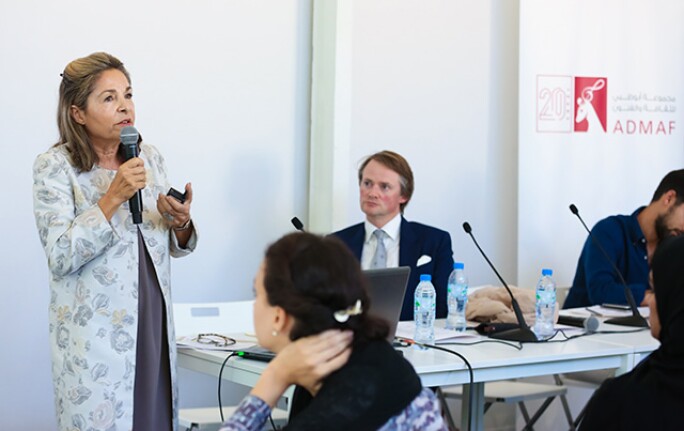A s the year draws to a close and international events continue to dominate public attention, one aspect of the Middle East remains robust. On the commercial front, a successful London sale in April 2017 was followed by the autumn cycle in October and then Dubai with a resounding success of $3.6m outcome. In Dubai participants from 33 countries marked the sale as a truly international event, and the eclectic mix of cross-categories from different time periods received a warm welcome from the buying public. At Bond St, the initiative of preceding sales with educational forums was also hugely welcomed – whether about Bahman Mohassess or Khalil Gibran, our public showed a real curiosity and appetite for learning.
A SELECTION OF WORKS FROM SOTHEBY'S INAUGURAL BOUNDLESS: DUBAI SALE
Across the globe, Middle Eastern artists were shown in both small and large venues, too many to mention in this space but certainly readers will remember Abdul Nasser Gharem at LACMA earlier last spring, Farideh Lashai at the Prado, Parviz Tanavoli at the Tehran Museum of Contemporary Art, the Afkhami Collection at the Aga Khan Museum, and Reza Derakshani/Alfred Basbous at S|2 Sothebys Hong Kong – not to mention a slew of offerings at the Venice Biennale. All were resounding successes, again demonstrating the international interest in art from the Middle East, even as US politicians clamp down on immigration and Brexit threatens the presence and flow of the relevant artists. Small wonder that Dubai is increasingly a sanctuary for regional artists and a hub for the visual arts – a matter which Sothebys acknowledged during ArtDubai 2017 by opening brand new premises at the DIFC.

ROXANE ZAND SPEAKS AT THE ART WORLD – AN INSIDE VIEW EVENT WHILE SOTHEBY’S EDWARD GIBBS LOOKS ON
On the institutional front, 2017 will herald the first ever regional museum dedicated to a solo female artist: Monir Farman Farmaian will be honoured on December 15 by the University of Tehran at the launch of The Monir Museum in the magnificent grounds of the Negarestan Museum Park Gardens. The Museum will be home to over 50 pieces from the artist’s personal collection, on permanent display for the public. Spanning over 60 years of Monir’s remarkable journey, the works in the museum trace the artist’s creative evolution, from delicate floral drawings to signature mirrored mosaic works that reference geometric principles found in early Islamic art. In both wall-hung and free-standing mirrored pieces, Monir fuses traditional mastery with contemporary abstraction, producing dazzling interplays of texture, light, colour and reflection. There will also be some of her most personal works across a diverse range of media. As the first Iranian female artist to be awarded a retrospective at the Guggenheim, the artist is the most celebrated of her generation, equalled only by Parviz Tanavoli, the father of modern Iranian sculpture who has held shows in major museums around the world.
PARVIZ TANAVOLI, LION (DETAIL), 2016, IN AN EXHIBITION AT TMOCA EARLIER THIS YEAR
Not to be missed before the year ends, is a small but wonderful exhibition at the British Museum: “On Violence and Beauty, Reflections on War” where the representation of war in four key objects from around the world and across history affords a special perspective on the topic. The oldest depiction on display is the ancient Egyptian Battlefield Palette, a double-sided relief carving made around 3300 BC which shows a violent scene of war casualties and the desire to defeat chaos and restore order. Alongside this is an Assyrian relief which illustrates the submission of Ituni after he witnesses the devastation around him. In addition to a Greek amphora depicting a mythical scene from the Trojan War, a work is shown by Iranian artist Farideh Lashai who has immortalized Goya’s famous ‘Disasters of War’ print series in a 2012-2013 digital incarnation called ‘When I count, There Are Only you …But Look, there is only a Shadow’. In it, the figures are removed from Goya’s etchings, and the works are displayed as a grid of 80 images projected across the grid which, when complemented by music, highlights the contradictions in relationship between the ugliness of war and the beauty of art.
SOTHEBY'S ASHKAN BAGHESTANI
I was discussing the past year with my colleague Ashkan Baghestani, and Head of Sale for Boundless: Dubai, who said “It’s been an outstanding year for Sotheby’s Middle East art team. We have been market leaders in 20th Century Art from the Middle East since reintroducing the sale last year and we’ve had a number of exceptional world and regional records this year including $1,271,000 for Fahrelnissa Zeid, coinciding with her retrospective at the TATE, and $750,000 for Bahman Mohasses. Another success was our inaugural Dubai Boundless sale which introduced some categories never offered before and also broke records for artists including $460,000 for Ali Banidsadr.”
The coming year promises even more, and we look forward both to institutional offerings, market successes, and increasing new artists across the Arab and Iranian art world.
Read Cultural Crossroads, my blog on the arts of the Middle East and North Africa.



